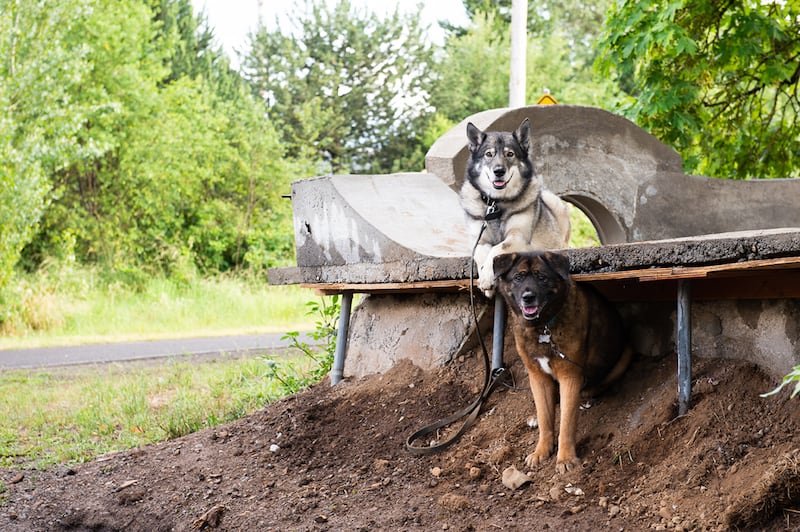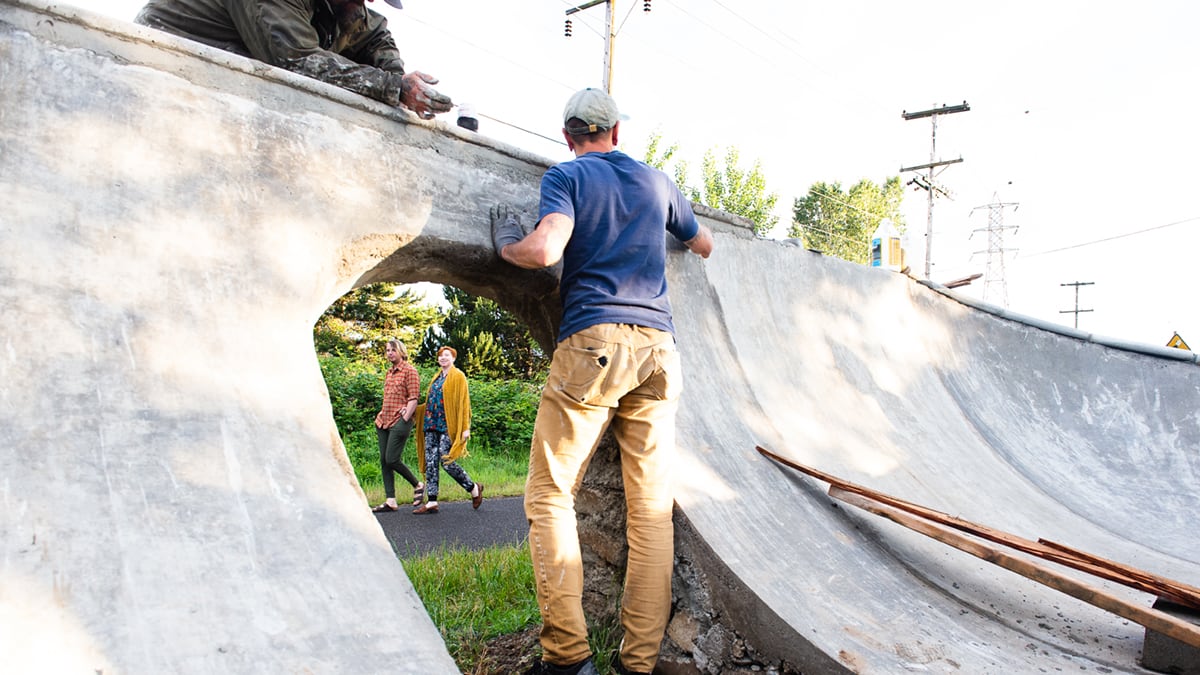Three years ago, an odd structure sprouted alongside the Springwater Corridor bike trail in deep Southeast Portland.
Residents in the Lents neighborhood are bitterly resigned to sprawling encampments appearing between the bike path and Interstate 205. But this was different: a low-lying three-dimensional patchwork of concrete ramps, with a dirt and asphalt channel running through the middle.
It was a skateboarding park—built by a guerrilla crew of Lents carpenters, masons and delivery drivers. And it kept growing. Each weekend, more people arrived to construct a roughly formed mini-halfpipe and bowl with steep and shallow embankments facing the street. They called the place Feral Cat Cove.
The skatepark has transformed a neglected strip of land owned by the city. “It was really gnarly,” recalls Alex Janega, a 34-year-old carpenter and father of one who helped build the park. “You’d find needles, human feces, bullet casings. There were stolen cars and RVs up and down the entire block.”
The founders of Feral Cat Cove opened the bowl to anyone: skaters, roller bladers, and kids on scooters. “My No. 1 rule is no cool-guy shit,” explains Janega. It has become a local gathering space in an area that was, until recently, strewn with trash.
Yet the skatepark could be demolished by City Hall—after complaints from the very neighborhood monitors who organized against homeless camping and drugs.
“I cannot stress enough that this is illegal,” says Penny Wilson, vice chair of the Lents Neighborhood Livability Association, an anti-crime group. She’s been contacting Portland Parks & Recreation for over a year, demanding that Feral Cat Cove come down. “No one has the right to just decide they want to build something on a piece of unincorporated or unimproved land and get away with it.”
Well, maybe. Portlanders have a proud tradition of crafting civic landmarks without formal sanction. (Most recently, an anonymous artist erected a urethane bust of York atop Mount Tabor.) Perhaps the most iconic installations are DIY skateparks.
Burnside Skatepark, one of the city’s most famous landmarks and hallowed ground in skateboarding history, just celebrated its 30th birthday in 2020. The park under the Burnside Bridge arguably inaugurated a DIY skate culture that inspired the people behind Feral Cat Cove. Like Feral Cat Cove, Burnside Skatepark was constructed without permission. It is now so established it has its own nonprofit and is working with City Hall to preserve the skateboarding bowl while seismic upgrades are made to the bridge overhead.
Since 1990, Portlanders have constructed countless skate spots across the city. Some as small as a patch of concrete at the base of a concrete barrier while others grow into entire neighborhood parks. Few get authorization.
“It’s so much easier to ask for forgiveness, you know,” says Colin Sharp of the nonprofit Skaters for Portland Skateparks, which spearheaded the now-defunct Brooklyn Street Skate Spot. The project ran for three years on a similar sleepy neighborhood corner in inner Southeast Portland before being demolished to make way for the TriMet Orange Line.
During that same period, at least five skateparks were leveled by the city and private developers. A DIY spot attached to the St. Johns Bridge was demolished last year after concerns were raised about effects on the bridge’s structural integrity. Another on Northeast Sandy Boulevard known as The Warf has been slated for demolition since winter and was recently fenced off by the property’s owners.
Others survived. Portland State University recently reached a temporary agreement with skateboarders who in recent years have built a series of wood and metal features on a paved court. Sharp has advice for keeping DIY skateparks out of the crosshairs of city officials: “Just keep it small, keep it local, keep it clean,” he says.

That’s not good enough for Wilson. The vice chair of a hardline group that demands a greater police presence in Lents, she says she objects to the project on grounds of safety and morality. (Other members of the association have been supportive of the project.)
She worries about kids skateboarding in the street, saying she gets “one or two reports of [cars] almost hitting kids weekly.” She tells this reporter about two separate fires on the Springwater Corridor in the past year that required the fire bureau to come out with ladder trucks—and worries that the skatepark does not leave the minimum required 20-foot width for fire apparatus access. (Janega disputes this. Gesturing to the channel through the middle of the park, he says, “We still have access right here for rapid response cleanup crew or the city if they need to get in here.”)
“I have been reporting this to the park bureau through their channels for two years,” Wilson laments. “Nobody took me seriously until about six or seven weeks ago.”
Portland Parks & Recreation knows about the park but hasn’t decided what to do. Parks bureau spokesman Mark Ross says parks leadership “is working to assess potential next steps. There is no imminent action, and no decisions have been made.”
For now, the park is open and expanding. “It’s a community,” says Josh, a 33-year-old stay-at-home dad who helped build the park but declined to give his last name. “We have plans to continue even further, and those ideas aren’t mine at all. Those are somebody else’s and like I’m super-stoked to start on, like, another brainchild of somebody else.”
On an unseasonably rainy afternoon at Feral Cat Cove, several men in their 20s and 30s are at work on the ramps. As the rain picks up, they huddle under a large tree for cover. Janega points to a metal grate in the middle of a skate ramp. “At least we know our drains work!” he says, smiling out from under a camouflage hat from Lowcard magazine.
A few minutes later, as the rain stops, the men make their way to the back wall of a newly poured concrete quarterpipe. This addition is noticeably smoother, appearing almost professionally built compared to earlier sections.
The team works together to install swimming pool-style coping at the top of the ramp. Everyone has a role: One guy mixes mortar in a bucket on the ground, Josh and another spread mortar and set pre-cut pool coping sections in place, and a third moves down the line cleaning up their work and smoothing things out. Around the back of the ramp, others are chatting about their day around a charcoal grill loaded with chicken thighs.
At least one neighbor thinks Feral Cat Cove beats anything offered to Lents by City Hall.
“City doesn’t come out and do anything,” says Wes Wolfe, a middle-aged man who says he owns a rental property around the corner, as he passes by the park on a stroll. “These guys, the skaters, they pick up the trash and they got a good attitude.”
